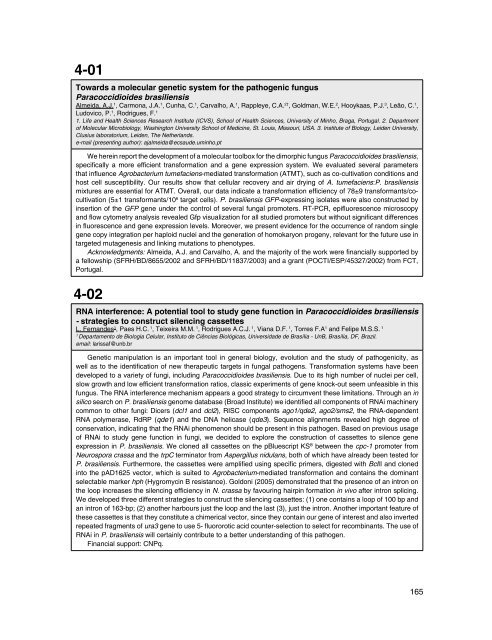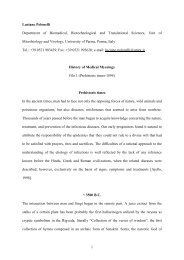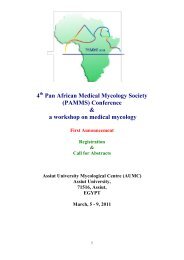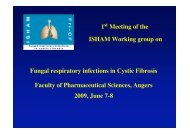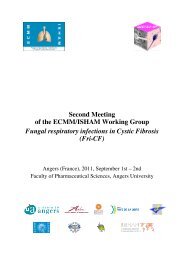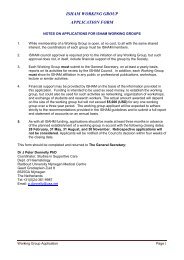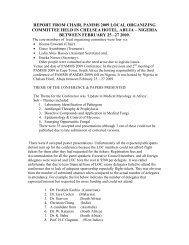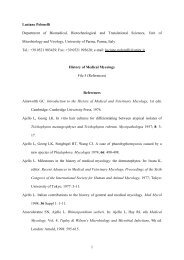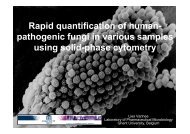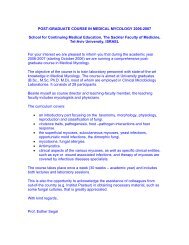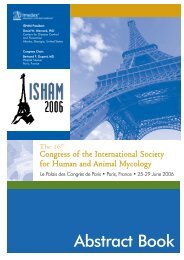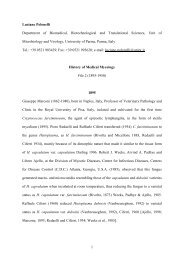Memoria CD.indd - ISHAM
Memoria CD.indd - ISHAM
Memoria CD.indd - ISHAM
You also want an ePaper? Increase the reach of your titles
YUMPU automatically turns print PDFs into web optimized ePapers that Google loves.
4-01Towards a molecular genetic system for the pathogenic fungusParacoccidioides brasiliensisAlmeida, A.J. 1 , Carmona, J.A. 1 , Cunha, C. 1 , Carvalho, A. 1 , Rappleye, C.A. 2† , Goldman, W.E. 2 , Hooykaas, P.J. 3 , Leão, C. 1 ,Ludovico, P. 1 , Rodrigues, F. 11. Life and Health Sciences Research Institute (ICVS), School of Health Sciences, University of Minho, Braga, Portugal. 2. Departmentof Molecular Microbiology, Washington University School of Medicine, St. Louis, Missouri, USA. 3. Institute of Biology, Leiden University,Clusius laboratorium, Leiden, The Netherlands.e-mail (presenting author): ajalmeida@ecsaude.uminho.ptWe herein report the development of a molecular toolbox for the dimorphic fungus Paracoccidioides brasiliensis,specifically a more efficient transformation and a gene expression system. We evaluated several parametersthat influence Agrobacterium tumefaciens-mediated transformation (ATMT), such as co-cultivation conditions andhost cell susceptibility. Our results show that cellular recovery and air drying of A. tumefaciens:P. brasiliensismixtures are essential for ATMT. Overall, our data indicate a transformation efficiency of 78±9 transformants/cocultivation(5±1 transformants/10 6 target cells). P. brasiliensis GFP-expressing isolates were also constructed byinsertion of the GFP gene under the control of several fungal promoters. RT-PCR, epifluorescence microscopyand flow cytometry analysis revealed Gfp visualization for all studied promoters but without significant differencesin fluorescence and gene expression levels. Moreover, we present evidence for the occurrence of random singlegene copy integration per haploid nuclei and the generation of homokaryon progeny, relevant for the future use intargeted mutagenesis and linking mutations to phenotypes.Acknowledgments: Almeida, A.J. and Carvalho, A. and the majority of the work were financially supported bya fellowship (SFRH/BD/8655/2002 and SFRH/BD/11837/2003) and a grant (POCTI/ESP/45327/2002) from FCT,Portugal.4-02RNA interference: A potential tool to study gene function in Paracoccidioides brasiliensis- strategies to construct silencing cassettesL. Fernandes 1 , Paes H.C. 1 , Teixeira M.M. 1 , Rodrigues A.C.J. 1 , Viana D.F. 1 , Torres F.A 1 and Felipe M.S.S. 11Departamento de Biologia Celular, Instituto de Ciências Biológicas, Universidade de Brasília - UnB, Brasília, DF, Brazil.email: larissaf@unb.brGenetic manipulation is an important tool in general biology, evolution and the study of pathogenicity, aswell as to the identification of new therapeutic targets in fungal pathogens. Transformation systems have beendeveloped to a variety of fungi, including Paracoccidioides brasiliensis. Due to its high number of nuclei per cell,slow growth and low efficient transformation ratios, classic experiments of gene knock-out seem unfeasible in thisfungus. The RNA interference mechanism appears a good strategy to circumvent these limitations. Through an insilico search on P. brasiliensis genome database (Broad Institute) we identified all components of RNAi machinerycommon to other fungi: Dicers (dcl1 and dcl2), RISC components ago1/qde2, ago2/sms2, the RNA-dependentRNA polymerase, RdRP (qde1) and the DNA helicase (qde3). Sequence alignments revealed high degree ofconservation, indicating that the RNAi phenomenon should be present in this pathogen. Based on previous usageof RNAi to study gene function in fungi, we decided to explore the construction of cassettes to silence geneexpression in P. brasiliensis. We cloned all cassettes on the pBluescript KS ® between the cpc-1 promoter fromNeurospora crassa and the trpC terminator from Aspergillus nidulans, both of which have already been tested forP. brasiliensis. Furthermore, the cassettes were amplified using specific primers, digested with BclII and clonedinto the pAD1625 vector, which is suited to Agrobacterium-mediated transformation and contains the dominantselectable marker hph (Hygromycin B resistance). Goldoni (2005) demonstrated that the presence of an intron onthe loop increases the silencing efficiency in N. crassa by favouring hairpin formation in vivo after intron splicing.We developed three different strategies to construct the silencing cassettes: (1) one contains a loop of 100 bp andan intron of 163-bp; (2) another harbours just the loop and the last (3), just the intron. Another important feature ofthese cassettes is that they constitute a chimerical vector, since they contain our gene of interest and also invertedrepeated fragments of ura3 gene to use 5- fluororotic acid counter-selection to select for recombinants. The use ofRNAi in P. brasiliensis will certainly contribute to a better understanding of this pathogen.Financial support: CNPq.165


